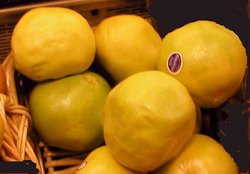Grapefruit (Citrus X paradisi) is a sub-tropical tree of the family Rutaceae and its citrus fruit.
The evergreen tree is usually found at around 5-6 m tall, although it can reach 13-15 m. The leaves are dark green, long (up to 15 cm) and thin. It produces 5 cm white four-petalled flowers. The fruit is yellow-skinned, largely oblate and ranges in diameter from 10-15 cm and has an acidic yellow segmented pulp. Varieties include the white grapefruit and the red, of which the 1929 US Ruby Red (of the Redblush variety) has a patent. The fruit has only become popular from the late 19th century, before that it was only grown as an ornamental plant. The US quickly became a major producer of the fruit, with plantations in Florida and Texas. In Spanish the fruit is known as the toronja.
The fruit was discovered in the 1750s probably in Barbados, currently the grapefruit is said to be one of the "Seven Wonders of Barbados." [1] (http://www.barbados.org/grapefrt.htm). It had developed as a natural cross of the pummelo (Citrus grandis) with the sweet orange (Citrus sinensis), it is rather closer to the first than the second. Further crosses have produced the tangelo (1905), the minneola (1931) and the sweetie (1984). Previously known as the shaddock, it was not called the grapefruit until the 1800s. Its current name alludes to clusters of the fruit on the tree. It was not distinguished from the pummelo botanically until the 1830s when it was given the name Citrus paradisi. Its true origins were not determined until the 1950s. This led to the official name being altered to Citrus X paradisi.
Grapefruit can have a number of interactions with drugs, often increasing the effective potency of compounds. Grapefruit contains naringenin and bergamottin, which inhibit the cytochrome P450 isoform CYP3A4 in the liver. It is via inhibition of this enzyme that grapefruit increases the effects of simvastatin, terfenadine, felodipine, nifedipine, verapamil, estradiol, midazolam, tacrolimus, and cyclosporine A. Grapefruit seed extract is a strong antimicrobial with proven activity against bacteria and fungi. It also has antioxidant properties.
Grapefruit formed a core part of the so-called grapefruit diet, under the pretext of being able to increase the metabolism and burn fat since grapefruit have a low glycemic index.
External links
- Grapefruit from "Fruits of warm climates" by Julia F. Morton (http://www.hort.purdue.edu/newcrop/morton/grapefruit.html)
- World's Northernmost Fruiting Grapefruit? in the Chelsea Physic Garden, london.
- Heggers JP et al., The effectiveness of processed grapefruit-seed extract as an antibacterial agent: II. Mechanism of action and in vitro toxicity. abstract
- University of Florida Institute of Food and Agricultural Services (http://edis.ifas.ufl.edu/BODY_CH063)
- Grapefruit Diet (http://www.dietsindex.com/learn/grapefruit-diet.html)- Overview, permitted foods, diet plan, advantages and disadvantages.

